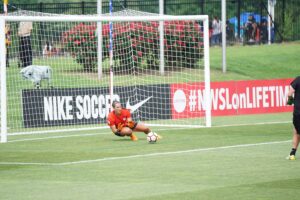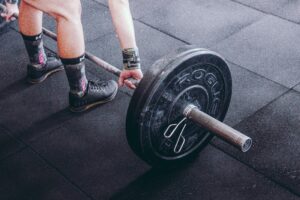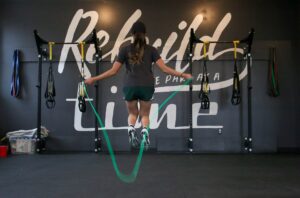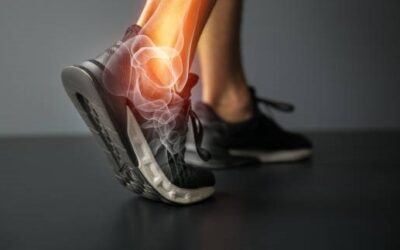Injuries lead to time away from the sport we love. If not treated appropriately, they result in additional games missed.
Being injured puts you at risk for:
- Losing your spot in the starting lineup
- Not having enough game film or field time with scouts present to get noticed for the next level
- Increased difficulty keeping up with your physical development
- Missing out on bonding with your teammates
- Including one of the worst consequences of an injury…It may even discourage you from returning to soccer altogether.

Losing the fire and passion you have for the sport can be devastating, especially in your youth.
So how do you prevent injuries from happening to avoid time lost?
First, let’s talk about the dynamics of the sport first. Soccer is one of the largest sports in the world. It is estimated that 250 million people of different ages and skill levels play soccer. That’s a lot of people and a lot of opportunities for injury.
Common Soccer Injuries
The most common injury site in soccer players is their leg (go figure). Common areas include the knee, ankle, and thigh.
We categorize sports injuries as contact and non-contact. Contact injuries occur when a force from another person is acted upon you. These can be accidental, or purposeful, contact with another player. Therefore you can not prevent them. For example, someone slide tackles you and you sustain a knee sprain. That injury occurred because the opponent put a force into you that caused your knee to bend in an awkward way.
Non-contact injuries are just what they sound like. They occur without contact with another participant. They typically occur when you are making a cut, slowing down too quickly, landing awkwardly, etc. Statistically, most injuries sustained in soccer are non-contact injuries. Non-contact injuries are the ones you can target your training to help reduce the risk of having them!
Let me be clear, there is no guarantee of not getting injured. But, you can most certainly reduce your risk of having a non-contact injury in soccer with an injury prevention program!
Risk Factors
There are a variety of risk factors related to non-contact injuries. Non-contact injuries are most likely to occur during the initial or final 15 minutes of a match. This occurs due to an improper warm-up or poor conditioning at the end of the game. These are two of the modifiable risk factors.
Additional modifiable risk factors include muscle weakness, poor landing mechanics, and impaired balance.
Unfortunately, there are non-modifiable risk factors as well. They are things such as age, gender, and anatomical makeup. (Hint, females are at a higher risk than males due to non-modifiable factors).
Younger athletes are at increased risk of injury due to poor motor control and not as developed skill level. Our motor control continues to be developed over time. Our youth really struggle with this because they are still growing into their body, per se. And, the more challenging the skill, the more mental and physical effort it takes to perform.
Your gender plays a role in your injury risk. Males are more likely to suffer from injuries overall, specifically muscle injuries. Females are more likely to suffer ligament injuries.
From a movement perspective, females typically present with increased knee valgus and hip internal rotation (knock knee). Simply put, females tend to have more knee collapse and knees over toes mechanics leading to increased quad strength and decreased glute strength, causing a muscle imbalance.
Males present with a “hip strategy” utilizing more of the glute muscles leading to decreased knee collapse.
The different hormones and hormone levels between males and females may also help explain the different types of injuries sustained. For example, estrogen has been found to cause greater laxity in tendons and ligaments.
The difference in bone development between males and females is also very different, which may help explain the difference in movement patterns.
Males tend to have a higher muscle mass than females, which may increase their risk of muscle injury.
ACL Injuries
ACL injuries are appearing more and more at every level of the game. Did you know an ACL injury is an example of a ligament injury?
With females having a higher risk of suffering from a ligament injury, this means that females are at a higher risk of having an ACL injury. This is especially seen in females between the ages of 15-20 years old attributed to changes in hormones. These females are 4-8x more likely to sustain an ACL injury.
Here’s another statistic for you. 1 out of 100 high school female athletes suffer an ACL injury and 1 out of 10 female collegiate athletes suffer an ACL injury.
That’s a pretty significant number. So we need to work on preventing ACL, or any other injury from becoming a bigger statistic.
Prevention
The best prevention programs are multi-faceted. Injury prevention programs need to be multi-dimensional in order for contact and non-contact injuries can be reduced. It includes an appropriate warm-up, strength and balance training, plyometrics, and proper landing mechanics.
Proper Warm-Up
Let’s talk about the warm-up first. The purpose of a warm-up is to prepare the body for what it’s about to do. The appropriate warm-up should include running, jumping, cutting, passing, dribbling, and shooting. Do those sound familiar? It should because you do all of those activities when you play soccer. Warm-ups including these types of movements have been shown to decrease injury risk by 30-56%.

Follow a Strength Training Program
Strength training decreases the risk of strength deficits between legs (ex. dominant vs non-dominant leg) and improves body mechanics while performing sport-specific activities such as jumping and cutting. This results in decreased risk due to improved movement patterns and motor control in those instances where you’re fatigued and trying to push through the final 10 minutes of the game. It also improves the body’s tolerance for unforeseen circumstances (like getting hit from behind or getting clipped in the ankle). Basically, building the strength and resilience in the muscles and ligaments in a controlled environment will help prepare the body when it needs to do that during the game.

Get Balanced
Balance training improves dynamic joint stability, which is a fancy way of saying it helps control the movement of the body during activity. In other words, it helps the player maintain balance when changing directions or position. ACL injuries typically occur when the knee rotates inward during deceleration or cutting. Performing balance training can help decrease the likelihood of this occurring due to the body’s ability to maintain balance during a transitional movement, such as cutting or decelerating. This results in improved mechanics as you move through those transitions, leading to decreased injury risk.
Increase Plyometrics
Plyometrics or jump training help improve the ability to perform explosive movements. Plyometric training leads to improved performance as it improves quickness, speed, and power. Cutting, jumping, and lateral movements are examples of plyometrics in sport. Being able to maintain proper form during these dynamic, explosive movements decreases injury risk. Landing mechanics are an important piece of plyometrics. Earlier I talked about the common position the knee is in when an ACL injury occurs and that most injuries in soccer are non-contact.

Training Proper Landing Mechanics
This brings us to the importance of proper landing mechanics. By training proper landing mechanics, athletes are better prepared to perform sport-specific movements while maintaining proper mechanics thus decreasing injury risk.
The other benefit to balance training, plyometrics, and landing mechanics is that we cannot always be “perfect”. In the heat of the moment, you’re not thinking about your landing mechanics. You’re thinking about scoring a goal. Training these movement patterns improves the body’s ability to tolerate “normal” and “abnormal” movements.
So, if someone ever tries to tell you that you move ‘different’, you probably do. If they tell you that movement is wrong, you should start to question them. ‘Different’ for you may be normal, but the important thing is that you have trained your body to be ready for that movement. The more you do it, the more of an expert you become at it.
Remember everyone’s anatomical makeup is different and everyone moves differently. Participation in an injury prevention screen can help tailor your program to help strengthen your movement patterns, make you more efficient, and perform better.
Now, What Should You Do?
The greatest risk factor of sustaining an injury is a prior history of the injury. If we can avoid the injury in the first place, there is a significant decrease in the risk of injury overall.
It is imperative to find the guidance of a professional when implementing these injury prevention programs to ensure proper mechanics, appropriate loading to stimulate the effect we are looking for, a proper progression of exercises, and ensuring all of these elements are addressed to get a well-rounded prevention program.
Working with a professional will increase the effectiveness of the injury prevention program.

If you are looking to maximize your injury prevention program to continue to have game film on yourself, please reach out!
Call our office at (480) 452-9191 or click here to fill out our free consultation form to and we will give you a call to set up an appointment!
We would love to assist your growth as an athlete and help you prolong your soccer career.




